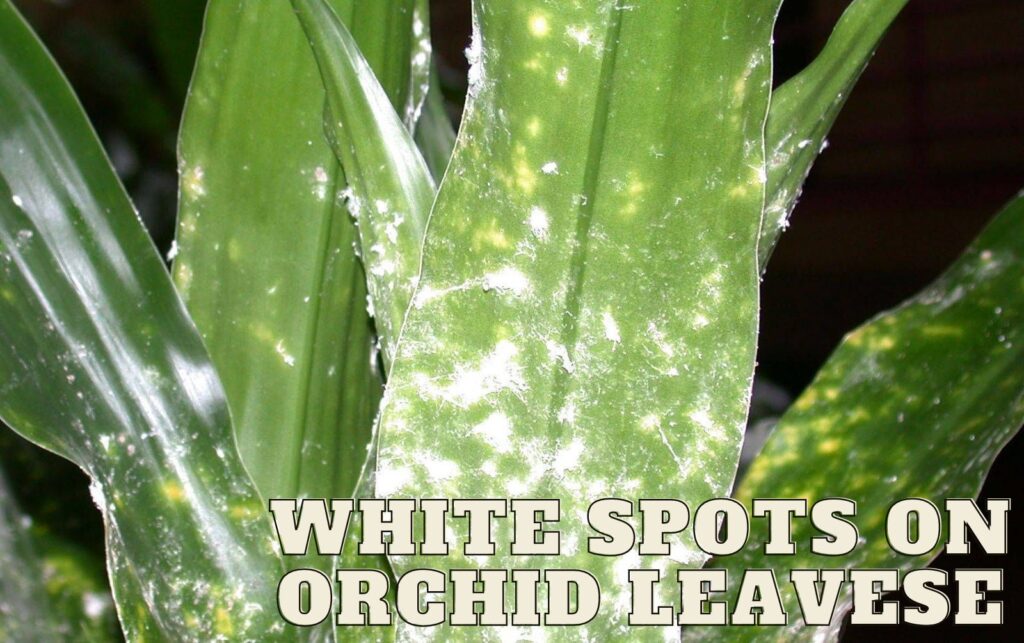
If the orchid blooms for a long time and brightly, this indicates that there are no problems in its development. If you begin to notice that white spots have formed on the leaves, then you need to keep a close eye on the plant. Read more about the appearance of white spots on orchid leaves in this article.
Why Are The White Spots On Orchid Leaves?
There are several reasons why white spots on orchid leaves appear. This may be non-compliance with the mode of moistening, lighting, and watering. In addition, diseases or tiny insects can serve as a source of fungal infections. You can read more about what causes spots on orchid leaves later.
Reason 1: wrong watering
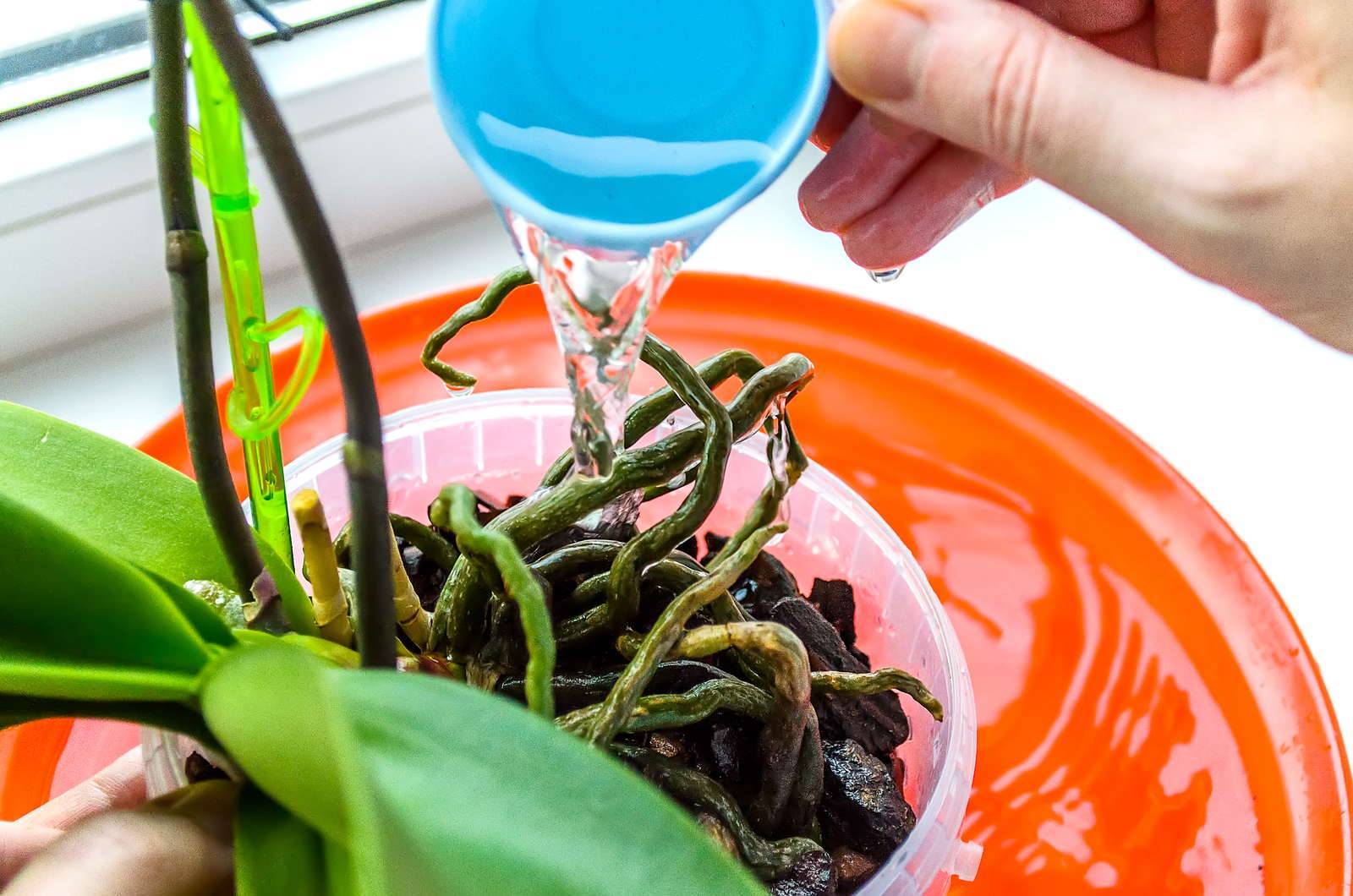
If white leaves began to form, likely, the reason lies precisely in the improper moistening of the epiphyte. Orchids, as you know, need rare, but plentiful watering.
All types of orchids need a normal watering schedule. Therefore, it is important to pay attention to which species you grow. During watering, you need to ensure that the leaves do not come into contact with water.
If drops of water fall, this contributes to the formation of white spots. In most cases, they have a notch in the center of the sheet plate.
Reason 2: low indoor humidity
Often the leaves turn white in the summer or during the heating season when waterlogging is unlikely. This happens for several reasons.
If the humidity in the room is low, and you forget to water the plant on time, the orchid suffers from excessive drying out. Therefore, white spots may form, which have a black border. In this case, the restoration of the bush is impossible, even if you start correcting the situation in time.

Reason 3: leaf burn or frostbite
Often, burns appear if the plant is constantly in contact with direct sunlight. Especially in spring and summer. If, in addition, water accumulates on the leaves, it works on the principle of a lens. Therefore, the negative impact of the sun increases.
Because of this, white and dry spots are formed on the leaves, which have a dark outline. If you touch the leaves and feel warm from them, try to shade the plant with curtains or paper. You can also remove the flower pot deep into the room.
Orchids are recommended to be placed on window sills, where diffused light prevails. You should also protect the orchid from frost. Even if you are transporting a flower from a store, it is better to do it in a car. Do not open windows for ventilation if there is an orchid nearby.
Even a slight frost can provoke yellow spots and white spots. If the temperature is in the range of 60 degrees, the bushes may frostbite. Also, make sure that the leaves do not come into contact with cold glasses.
Reason 4: powdery mildew attack
The question often arises, what does fungus look like on orchids? If white spots appear on the leaves of the orchid, then there is a possibility that the infected plants with a fungal infection – powdery mildew.
After, the spots begin to transform and become yellow-gray. Subsequently, they begin to dry out and provoke the death of leaf plates. Fungal diseases begin to appear for several reasons, namely:
- introduction of an excessive amount of nitrogen fertilizing;
- wrong watering;
- constant temperature change in the room.
In most cases, plants that have a weakened immune system suffer from fungal disease.
Reason 5: Mealybug

It is not uncommon for the leaves to turn white if the orchid encounters a mealybug infestation. Determining the presence of a parasite is quite easy. Hairy lumps appear on the leaves, which resemble the cotton swab. Also, sticky and viscous discharge may indicate the parasite.
Parasites begin to settle in the axils of the leaf, as well as on its backside. After the colonies begin to spread throughout the plant, in a serious case, the roots can become infected. Several reasons provoke a mealybug, namely:
- low indicators of humidity;
- excessive watering;
- lowering the temperature in the room;
- excessive application of nitrogen-containing fertilizers.
The parasite can be brought on clothes or when buying a new flower. Therefore, you should be especially careful.
Reason 6: diseases
About 20 varieties of viruses are common in the orchid world.
The most common types of viruses that lead to the formation of spots on orchid leaves:
- Cymbidium mosaic virus (CMB). Penetrates through cuts and insect bites. It appears on the back of the leaves in the form of white spots with stripes. Not amenable to treatment.
- Phalaenopsis chlorosis spot virus (PCSV). It leads to a violation of the formation of chlorophyll in plant cells and a decrease in photosynthesis. At first, the leaves are covered with pink and yellow spots, which then turn white. Cattleyas, Phalaenopsis, and dendrobiums are at risk. With a slight spread, the orchid can be cured.
- Orchid fleck virus (OFV). Appears mainly on old sheet plates. Their inner part is covered with circles, dots, and stripes. After a while, the spots dry up and acquire a gray-white tint. A fungus can join the virus, and the injured areas may turn black.
- Taiwan-Virus or Capsicum chlorosis virus (CCV). In most cases, it settles on young seedlings of Phalaenopsis. External manifestations are barely noticeable on the leaves in the form of small light white spots. Flowers and buds do not suffer.
- Dendrobium mosaic virus (DMV). The leaves are covered with depressed white spots in the form of rhombuses with oval or ring stains. It mainly attacks natural epiphytes. Rarely found on hybrid varieties. Not subject to treatment.
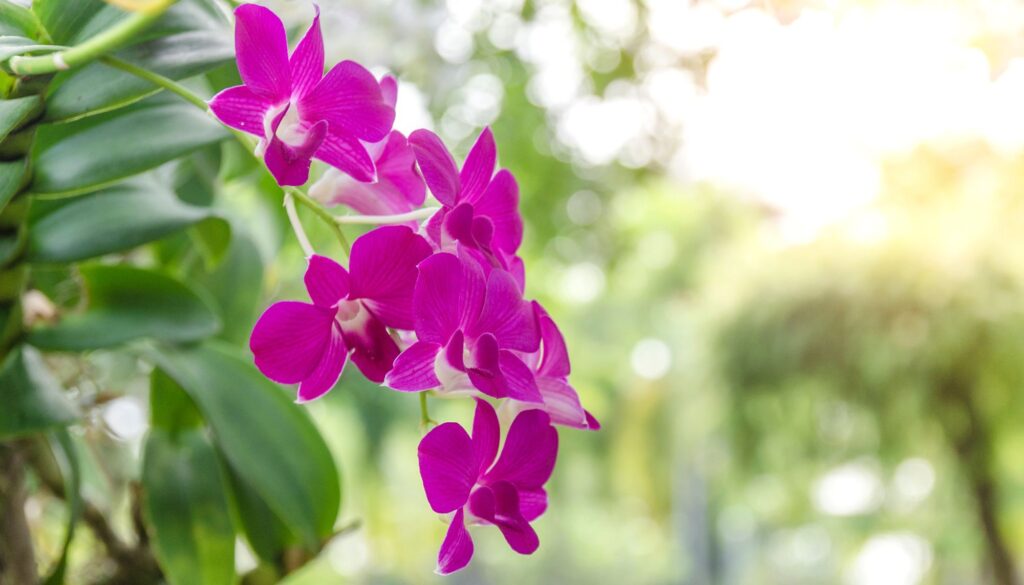
Determination of the exact cause by external signs
What to do if white spots appear on the leaves of an orchid, how to identify the cause of the disease by external manifestations?
- white weeping spots and swelling – prolonged exposure to water on the orchid;
- white sunken spots – the result of improper watering, as a rule, they appear with excessive moistening with hard water;
- white spots with a black rim – the consequences of keeping the orchid in the open sun or near an incandescent lamp;
- white hairy spots – the invasion of a colony of mealybugs;
- white dots on the leaves – growing a flower on a cold windowsill at low temperatures;
- leaves and stems turned white – the orchid plants have fungal infections;
- white streaks on leaves – spread of a viral disease;
- white stripes along the leaf – cracks in the leaf, the likely cause is over-watering;
- depressed white dots – mechanical damage, maybe when the orchid is standing outside. Damage caused by rain or hail.
What to do to eliminate white spots on orchid’s leaves?
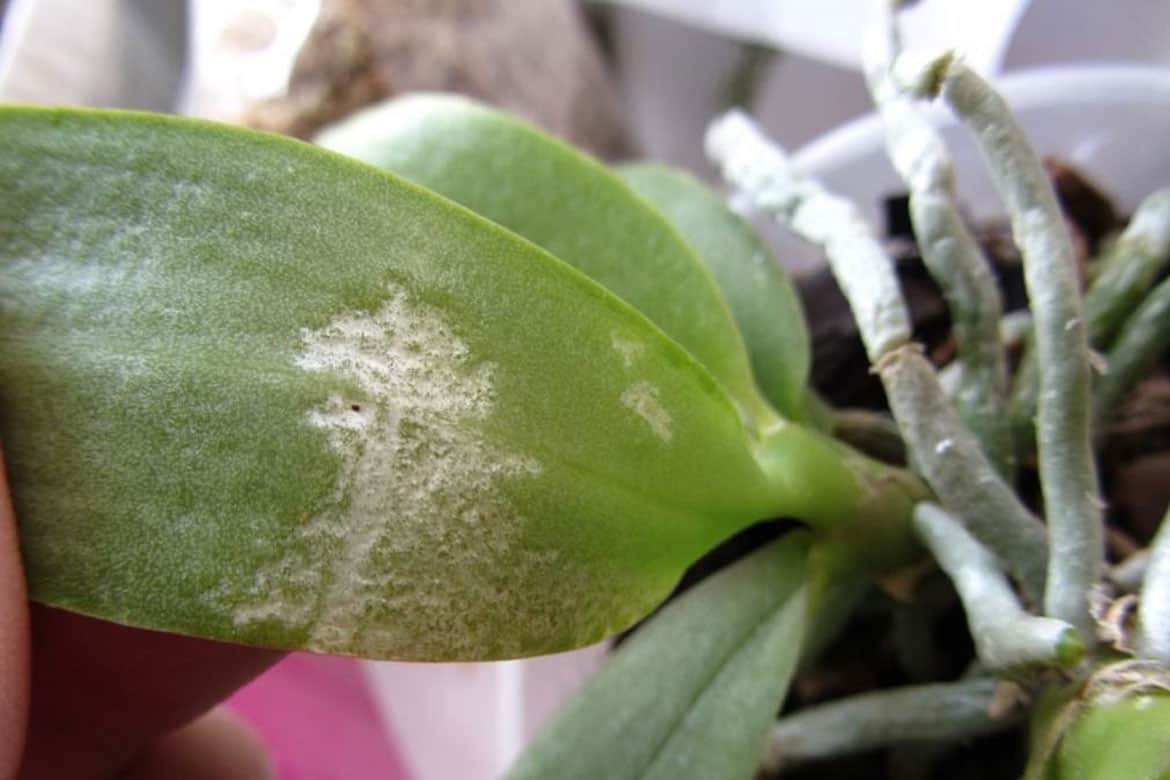
Read also: Healthy orchid roots
Quite often people wonder, about the white spots on orchid leaves – what they are & solutions?
To save the orchid from unsightly spots on orchid leaves, you should radically change the mode of keeping the flower and, if necessary, conduct a comprehensive treatment.
Recovery after waterlogging. Resuscitation after a burn
If the soil has too much moisture, it makes sense to apply several actions, namely:
- Carefully remove the bush from the pot.
- Clear the roots from the soil.
- Remove affected areas that have been injured, have a bacterial brown spot, or have begun to rot.
- Treat wounds with crushed wood charcoal.
- Leave in the air to dry the roots.
- Transplant into a clean orchid pot filled with new soil.
If the orchid leaves are already affected by white spots, it is impossible to restore them. You’ll have to cut them off. To do this, use a sharp knife, which must first be sterilized. Thanks to this, the flower begins to look better.
If the orchid leaves have turned white in the sun, place the plant in a shady area that gets some diffused light. Then adjust watering. Until the flower recovers, exclude fertilization. If the spot is located in the center of the leaf plate, you need to wait for the leaf to dry completely, and then cut it off.
Dried flower care
For the plant to stop fading, the watering process should be restored. In summer, the plants are watered 2-3 times a week. In winter, the watering interval is 1-2 times a week.
If the weather is hot in summer, watering may be somewhat more frequent. The soil must be constantly kept moist. Orchids are recommended to be watered by the submersible method:
- Fill the container with clean water. Its temperature should be at room temperature.
- Put the pots in the liquid. Water seeps through the holes in the pot. The neck must be left dry.
- Wait up to 20 minutes, then remove the pot from the water and let the excess drip off.
This saturates the soil with water, and the plant is sufficiently moistened for a long time.
Powdery mildew treatment. Fight with a worm

If white spots similar to powdery mildew appear on the orchid leaves, many are wondering, how do you treat white spots on orchid leaves?
It is urgent to quarantine the infected bush away from other orchids.
After that, you should apply the following actions:
- Rinse existing stains underwater. However, it is best to wipe them with a cotton pad, which must be moistened with soapy water, or use horticultural oil.
- Cut off the orchid’s leaves that have been infected.
- Sprinkle with charcoal, and replace the substrate.
This stops the development of fungal infections. You can also use insecticides, which are applied at intervals of 1.5-2 weeks. They need to be used for irrigation.
If white furry spots appeared on the orchid, then the plant was affected by a mealybug. First, trim the damaged leaf plates and peduncles. In the end, wipe the orchid leaves with insecticidal soap.
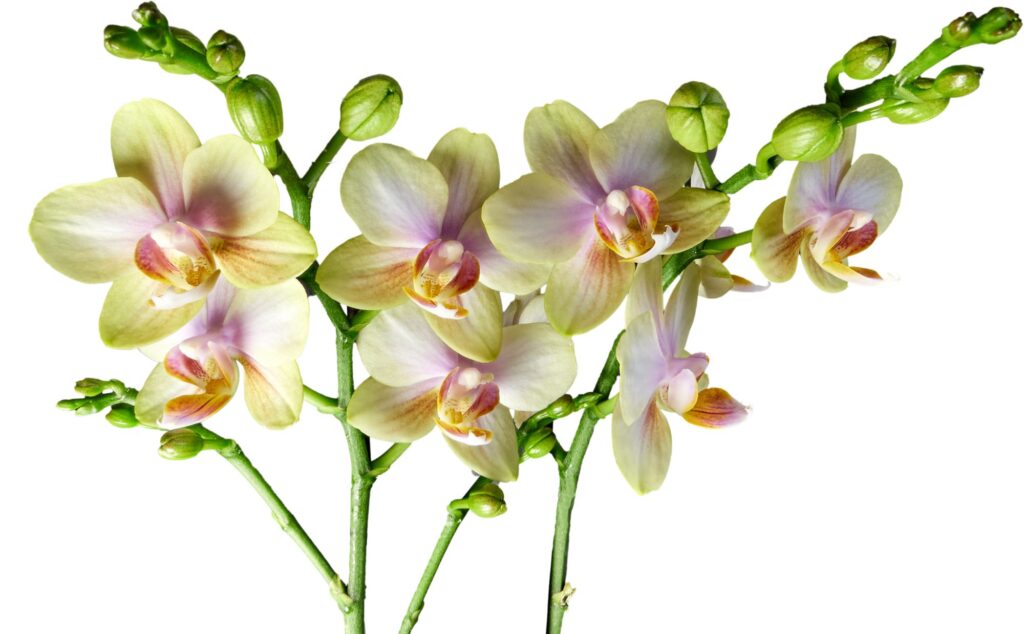
Results
As you can see, spots on orchid leaves are quite common and can appear for various reasons. It is very important to carefully monitor the condition of the plants to immediately begin to solve the problem that has arisen. Wonder why orchid leaves turning brown, read the article.
Read also:
How do you treat white spots on orchid leaves?
To treat white spots on orchid leaves, remove any affected parts, isolate the plant, and treat with fungicide or bactericide if necessary. Ensure good air circulation and avoid overwatering or high humidity to prevent further infections.
Why does my orchid have white spots?
White spots on an orchid can be caused by various issues, including fungal or bacterial infections, pests, or sunburn. Fungal or bacterial infections can occur due to overwatering or high humidity, while pests such as spider mites or mealybugs can cause white spots on the leaves. Sunburn can also cause white or yellow spots on the leaves if the plant is exposed to too much direct sunlight. It’s important to identify the underlying issue and address it promptly to prevent further damage to the plant.
Why does my orchid have spots on its leaves?
Orchid leaves may develop spots due to fungal or bacterial infections, pest infestations, sunburn, nutrient deficiencies, or mechanical damage. Identifying the cause is important to determine the appropriate treatment, such as using fungicides or bactericides for infections, insecticides for pests, and providing shade or fertilizers for sunburn or nutrient deficiencies.
Why does my orchid have white fungus on the leaves?
White fungus on orchid leaves can be a sign of fungal infection, which can occur due to overwatering or high humidity. The fungus may appear as powdery or fuzzy white spots on the leaves or flowers. It’s important to identify and address the underlying issue to prevent further damage to the plant. This may involve adjusting the plant’s watering schedule, improving air circulation, or treating it with appropriate fungicides.
What does a dehydrated orchid look like?
A dehydrated orchid may have wrinkled, dry, or wilted leaves that appear yellow or brown. The potting medium may also be dry and hard, and the roots may appear dry or shriveled. The plant may also show signs of stress, such as drooping leaves or flowers. If the orchid is dehydrated, it’s important to water it thoroughly and provide it with adequate humidity to restore its health.
